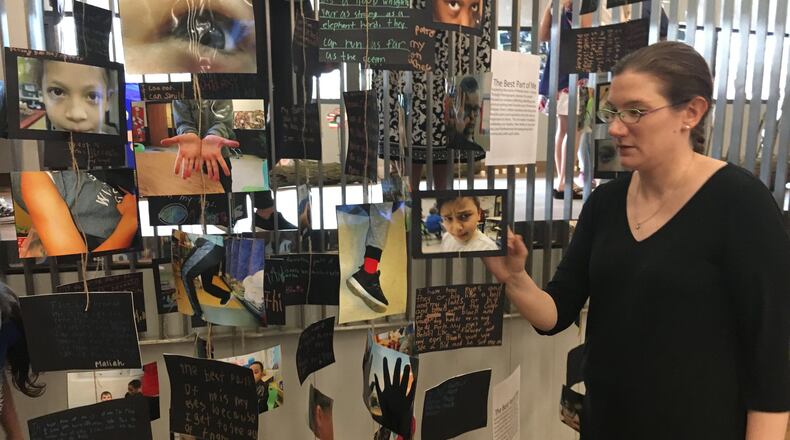RELATED: ‘Turning the corner’ for Dayton schools: Expand this after-school program
Ruskin serves a largely poor neighborhood, scarred with abandoned homes and working to recover from the opioid crisis.
Miracle Makers Education Director Ellen Mays said the project empowered “People that are usually a marginalized community, giving them a space where their voice is heard.”
For 10 weeks, roughly 250 students and parents photographed their neighborhood and their lives, the things they love and the things they want to see changed.
On a 40-foot skyline banner, kids pasted pictures they took on a walk of their neighborhood; photos of playgrounds they enjoy playing in and burned out houses they wish people would tear down. They added notes such as “In my community, I love to be kind.”
RELATED: 50-plus ways you can help 6 Dayton schools, thousands of students
Kids explored who they were and their favorite parts of themselves with other exhibits. University of Dayton graduate student Tom Cook showed a rough cut of a documentary he’s doing on the program:
Another exhibit featured family portraits showing how diverse Ruskin families are, yet how they are based on love.
“It gave us an opportunity to learn about each other,” said Sharae Clay, whose fifth-grade daughter attends Ruskin. “To learn each other’s stories, to learn each other’s struggles.”
Another portion of the exhibit featured photographs from parents and notes on their hope for the community. Many wanted the drugs, garbage and abandoned homes cleaned up.
RELATED: Dayton to close a school, shake up teaching staff, open health center
Clay said she hopes the community leaders who attended the library event consider why they think it’s OK for her neighborhood to be strewn with trash and burned-out buildings.
“I think it’s because they think we’re not worth it,” she said. “Well, you’re wrong, because we are.”
Before they left, attendees were asked to write down on a cut-out handprint some task, large or small, they can commit to in response to the photos they saw. Kids wrote things like “I will throw trash in the trashcan.” Adults wrote things like “Take price in my community and improve the things I can.”
About the Author

